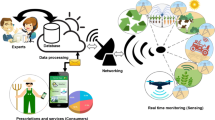Abstract
Energy-efficient, reliable and scalable machine-to-machine (M2M) communications is the key technical enabler of Internet-of-Things (IoT) networks. Furthermore, as the number of populated devices is constantly increasing, self-sustaining or energy-autonomous IoT nodes are a promising prospect receiving increasing interest. In this paper, the feasibility and fundamental limits of energy harvesting based M2M communication systems are studied and presented. The derived theoretical bounds are effectively based on the Shannon theorem, combined with selected propagation loss models, assumed link nonidealities, as well as the given energy harvesting and storage capabilities. Fundamental limits and available operational time of the communicating nodes are derived and analyzed, together with extensive numerical results evaluated in different practical scenarios for low power sensor type communication applications.









Similar content being viewed by others
References
J. Rinne et al., “Feasibility and Fundamental Limits of Energy-Harvesting Based M2M Communications,” in Proc. IEEE 27th Annual International Symposium on Personal, Indoor, and Mobile Radio Communications (PIMRC), pp. 318-323, Sept. 2016.
Ericsson, Mobility report, Nov. 2016. Available [online] at https://www.ericsson.com/assets/local/mobility-report/documents/2016/ericsson-mobility-report-november-2016.pdf
S. Andreev et al., “Understanding the IoT Connectivity Landscape: A Contemporary M2M Radio Technology Roadmap”, IEEE Comm. Mag. Communications Standards Supplement, vol. 53, no. 9, pp. 32–40, Sept. 2015.
V. Raghunathan, C. Schurgers, P. Sung and M. B. Srivastava, “Energy aware wireless microsensor networks”, IEEE Signal Process. Mag., vol. 19, no. 2, pp. 40-50, Mar. 2002.
S. Sudevalayam and P. Kulkarni, “Energy harvesting sensor nodes: Survey and implications,” IEEE Commun. Surveys Tuts., vol. 13, no. 3, pp. 443-461, 3rd Quart. 2011.
X. Chen et al., Low power sensor design for IoT and mobile healthcare applications, China Communications, vol. 12, no. 5, pp. 42-54, May 2015.
S. Ulukus et al., “Energy Harvesting Wireless Communications: A Review of Recent Advances”, IEEE Journal on Selected Areas in Communications, vol. 33, no. 3, pp. 360-381, March 2015.
S. Lehtimaki, S. Tuukkanen, J. Porhonen, P. Moilainen, J. Virtanen, M. Honkanen, and D. Lupo, “Low-cost solution processable carbon nanotube-based supercapacitors and their characterization,” Appl. Phys. A, 2014.
G. Nisato, D. Lupo, and S. Ganz, Organic and Printed Electronics: Fundamentals and Applications, Pan Stanford, 2016.
J. Keskinen, S. Lehtimaki, A. Dastpak, S. Tuukkanen, T. Flyktman, T. Kraft, A. Railanmaa and D. Lupo, “Architectural modifications for flexible supercapacitor performance optimization”, Electronic Materials Letters, 2016. doi:10.1007/s13391-016-6141-y.
S. Lehtimaki et al., “Performance of printable supercapacitors in an RF energy harvesting circuit,”, Int. Journal of Electrical Power and Energy Systems, vol. 58, pp. 42-46, 2014.
C. E. Shannon, “A mathematical theory of communication,” ACM SIGMOBILE Mobile Computing and Communications Review, vol. 5, no. 1, pp. 3-55, Reprinted (with corrections from Shannon 1948), 2001.
Rec. ITU-R P.372-12, “Radio Noise,” ITU-R Geneva, July 2015.
J. G. Proakis, Digital Communications, 4th ed., McGraw-Hill, 2000.
S. ten Brink, “A rate one-half code for approaching the Shannon limit by 0.1dB”, IEE Electronics Letters, vol. 36, no. 15, pp. 1293-1294, July 2000.
F. K. Shaikh and S. Zeadally, “Energy harvesting in wireless sensor networks: A comprehensive review”, Renewable and Sustainable Energy Reviews, vol. 55, pp. 1041-1054, 2016.
G. Tuna and V. C. Gungor, “Energy harvesting and battery technologies for powering wireless sensor networks,” Industrial Wireless Sensor Networks: Monitoring, Control and Automation, pp. 25-38, 2016. doi:10.1016/B978-1-78242-230-3.00002-7.
D. Niyato, E. Hossain, M. Rashid and V. Bhargava, “Wireless sensor networks with energy harvesting technologies: A game-theoretic approach to optimal energy management”, IEEE Wireless Communications, vol. 14, no. 4, pp. 90-96, 2007.
J. A. Paradiso and T. Starner, “Energy scavenging for mobile and wireless electronics,” IEEE Pervasive Comput., vol. 4, no. 1, pp. 18-27, Jan.-Mar. 2005.
J. Bird, Electrical and Electronic Principles and Technology, Routledge, 2010.
L. Gu et al., “Radio-triggered wake-up for wireless sensor networks”, Real-Time Sys., vol. 29, no. 2, pp. 157-182, 2005.
J. Ansari et al., “Radio-triggered wake-ups with addressing capabilities for extremely low power sensor network applications”, Int J. Wireless Inf Networks, vol. 16, no. 3, pp. 118-130, July 2009.
M. T. Penella-Lopez and M. Gasulla, Powering Autonomous Sensors: An Integral Approach with Focus on Solar and RF Energy Harvesting, 1st ed., Springer, 2011.
IEEE P802.11 Wireless LANs TGah Channel Model, (doc.: IEEE 802.11-11/0968r4), March 2015.
Rec. ITU-R P.525, “Calculation of free-space attenuation,” ITU-R Geneva, Aug. 2003.
Acknowledgements
This is an extended version of the earlier published paper by Rinne et al. [1], presented in IEEE PIMRC 2016. This work was financially supported by the Finnish Funding Agency for Technology and Innovation (Tekes), under the project PAUL.
Author information
Authors and Affiliations
Corresponding author
Rights and permissions
About this article
Cite this article
Rinne, J., Keskinen, J., Berger, P.R. et al. Feasibility and Fundamental Limits of Energy-Harvesting Based M2M Communications. Int J Wireless Inf Networks 24, 291–299 (2017). https://doi.org/10.1007/s10776-017-0358-z
Received:
Accepted:
Published:
Issue Date:
DOI: https://doi.org/10.1007/s10776-017-0358-z




